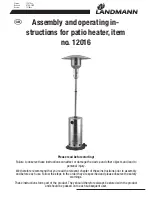
17
March 2011
Flex Fuel Owner’s Manual
5.5 Electrical Connections
Note: Be sure to follow all local, state and federal guidelines. Wiring installation should be preformed
by a qualified electrician.
Main Power Connection
Your Flex fuel needs a 120 V connection with a 20 amp circuit for the basic unit.
The unit must be properly grounded to ensure proper operation. Failure to properly ground the unit will
result in a voided warranty.
Secondary Power Connections
Secondary power connections include a pump, igniter (optional) and the pellet arm (optional).
Main Circulating Pump
Your Flex fuel comes with the proper wiring harness and connections to power a pump at the rear of the
furnace. Pump wiring must be done by a qualified electrician.
5: Installation
Filling the Furnace and Buffer With Water
Your Flex fuel furnace should be filled with clean drinking water that has minimal water impurities. Do
not fill your furnace with water from lakes, rivers, ponds, etc.
Your Flex fuel furnace can be filled with water by adding water to the expansion tank above the furnace.
Ensure that you leave enough room in the expansion tank for when the water is heated to avoid water
from spilling over.
The buffer tank(s) should be filled from the bottom of the tank. while filling the tank the valve on the top
should be open to vent the air out of the system. Once all the air is out of the tank close the top valve.
It is necessary to monitor and bleed off any excess air that may be in the system once the furnace is
operational. However do not try to bleed the buffer tank while the pumps are running. Any air in the
furnace will self bleed into the expansion tank.
Boiler treatment must be used with all water types and system configurations. Antifreeze can be added
to systems that have components that may be subject to freezing if the furnace is not run for an
extended period of time. Boiler treatment must still be used even when antifreeze is present in the
system.
Setting the Diverting Valve
Your furnace requires a return water temperature minimum of 140°F during operating. Adjusting the
valve is a one time process during the initial firing. Start the process by having the valve at the
maximum setting. Start adjusting when the bottom of your buffer tank is below 130°F and the furnace is
above 150°F. Adjust the valve down and monitor the water temperature on the display. Once the furnace
display reads between 140°F and 150°F for the return water temperature the valve is adjusted properly.
















































